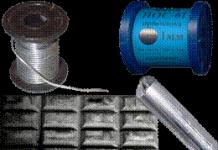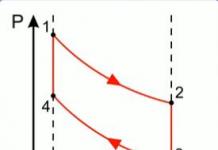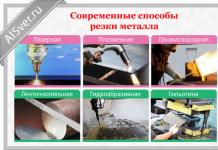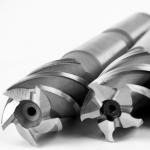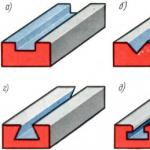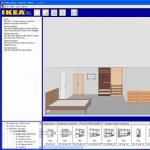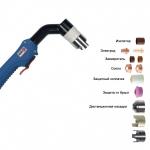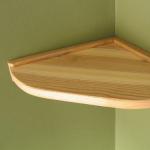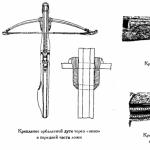ledge called a recess bounded by two mutually perpendicular planes forming a step. The detail can have one, two, three or more ledges (Fig. 55).
Rice. 55. Ledges
Groove- a recess in a part, limited by planes or shaped surfaces. Depending on the shape of the recess, the grooves are divided into rectangular, L-shaped and shaped (Fig. 56, a, 6, c, d, e, f).

Rice. 56. Types of grooves by shape
The grooves of any profile can be through (Fig. 57, a), open or with an exit (Fig. 57, c) and closed (Fig. 57, c).

Rice. 57. Grooves through, with an exit and closed
The processing of ledges and grooves is one of the operations performed on milling machines.
Milled ledges and grooves are subject to various technical requirements depending on the purpose, batch production, dimensional accuracy, location accuracy and surface roughness. All these requirements influence the choice of processing method.
Milling of ledges and grooves is carried out by disk end mills, as well as by a set of disk cutters. In addition, ledges can be milled with face mills.
Shoulder and slot milling with disc cutters
Disc cutters designed for processing planes, ledges and grooves.
Distinguish disc cutters solid and with false teeth. Solid disk cutters are divided into grooved (GOST 3964-69), grooved backed (GOST 8543-72), three-sided with straight teeth (according to GOST 3755-69). three-sided with multidirectional fine and normal teeth (GOST 8474-60). Milling cutters with false teeth are made three-sided (GOST 1669-69). Disc groove cutters have teeth only on the cylindrical part, they are used for milling shallow grooves. The main type of disc cutters are three-sided. They have teeth on the cylindrical surface and on both ends. They are used for processing ledges and deeper grooves. They provide a higher class of roughness of the side walls of the groove or ledge. To improve cutting conditions, triangular disk cutters are equipped with oblique teeth with alternating flute directions, i.e. one tooth has a right-hand groove direction, and the other, adjacent to it, has a left-hand one. Therefore, such cutters are called multidirectional. Due to the alternating inclination of the teeth, the axial components of the cutting force of the right and left teeth are mutually balanced. These cutters have teeth on both ends. The main disadvantage of three-sided disc cutters is the decrease in width after the first regrinding along the end face. When using adjustable cutters, consisting of two halves of the same thickness with overlapping teeth in the socket, after regrinding, it is possible to restore the original size. This is achieved by using spacers of appropriate thickness, made of copper or brass foil, which are placed in the slot between the cutters.
Circular cutters with insert knives equipped with hard alloy plates are three-sided (GOST 5348-69) and two-sided (GOST 6469-69). Three-sided disc cutters are used for milling grooves, and double-sided for milling ledges and planes.
Insert knives are fastened into the body for both types of cutters using axial corrugations and a wedge with an angle of 5 °. The advantage of this method of insert knife attachment is the ability to compensate for wear and the layer removed during regrinding. Restoring the size in diameter is achieved by rearranging the knives by one or more corrugations, and in width - by the corresponding extension of the knives. Three-sided cutters have knives with an alternately alternating inclination with an angle of 10 °, for two-sided - in one direction with an inclination angle of 10 ° (for right-handed and left-handed cutters).
The use of triangular disc cutters with carbide inserts gives the highest productivity in the processing of grooves and ledges. A disc cutter "holds" the size better than an end cutter.
Choice of type and size of disc cutters. The type and size of the disc cutter is selected depending on the dimensions of the surfaces to be machined and the material of the workpiece. For given processing conditions, the type of cutter, the material of the cutting part and the main dimensions - D, B, d and z are selected. For milling easily machined materials and materials of medium processing difficulty with a large milling depth, milling cutters with normal and large teeth are used. When machining difficult-to-cut materials and milling with a small depth of cut, it is recommended to use milling cutters with normal and fine teeth.
The diameter of the cutter should be chosen as small as possible, since the smaller the diameter of the cutter, the higher its rigidity and vibration resistance. In addition, with an increase in the diameter of the cutter, its cost increases.

Rice. 58. Choosing the diameter of disc cutters
As seen in fig. 58, with a milling depth t and a guaranteed gap between the setting ring and the workpiece within (6÷8) mm, the condition must be met
D - d 1 = 2(t + (6÷8)) mm,
where we get the expression for choosing the minimum diameter of the cutter
D = 2t + d 1 + (12÷16) mm,
where d 1 is the diameter of the cutter hub (adjustment ring).
The table shows the dependence of the diameter of the hub of the cutter d 1 on the diameter of the hole for disk cutters.

We will explain the adjustment and adjustment of the machine for milling ledges with disk cutters using the example of processing ledges of a prism (Fig. 59, a, b). The choice of the size of the disc cutter depends on the size of the ledge, the grade of the material being processed, the power of the machine's electric motor and other conditions.

Rice. 59. Prism
Shoulder milling with disc cutters, as mentioned above, is usually done with a double-sided disc cutter. However, in our case, a three-sided cutter should be chosen, since it is necessary to alternately process one ledge on each side of the prism (Fig. 60, a, b). We choose a three-sided cutter with insert knives according to GOST 5348-69, equipped with T15K6 hard alloy plates. Cutter diameter D = 100 mm, width B = 18 mm, number of teeth z = 8. When milling grooves and ledges, the vise must be aligned with a thickness gauge or indicator with a stand and secured. We install and fix the workpiece in a machine vice with a lining. Fixing a disk cutter on a mandrel is carried out in the same way as a cylindrical cutter. Milling modes are selected either from reference books, if they are not indicated in operational cards, or directly from operational or instructional cards.

Rice. 60. Shoulder milling with a disc cutter
Milling mode for our case: B = 13 mm, t = 4 mm, s z = 0.06 mm/tooth, v = 335 m/min. According to the schedule (see Fig. 40), we determine the number of revolutions of the machine spindle - 1000 rpm.
According to the schedule (see Fig. 41), we determine the minute feed - s m \u003d 500 mm / min. Then we adjust the machine for the required number of revolutions of the machine spindle and the required minute feed. The milling of each ledge consists of the following basic techniques:
1. By pressing the "Start" button, turn on the electric motor. The spindle must rotate in the opposite direction of the helical groove of the cutter.
2. Bring the workpiece by manually moving the table of the handles of longitudinal, transverse and vertical movement under the rotating cutter until the side cutting edges of the workpiece lightly touch. Then, by turning the vertical feed handle, lower the table until the cutter exits the workpiece. Then, by turning the cross feed handle, move the workpiece in the direction of the cutter by 13 mm, using the cross feed dial. Raise the table until the rotating cutter lightly touches the upper plane of the workpiece. By rotating the longitudinal feed handle, remove the workpiece from under the cutter, turn off the machine and raise the table by 4 mm, using the vertical feed dial. Lock the vertical and cross slides.
3. Set the cams for the mechanical switch-off of the longitudinal feed of the table to the milling length. Turn on the spindle rotation again, manually feed the workpiece by rotating the handle of the longitudinal feed of the table towards the rotating cutter, turn on the mechanical longitudinal feed and mill the first ledge (see Fig. 60, a). Turn off the machine without moving the table.
Check the size of the machined ledge in width and depth using a caliper. If the size is inaccurate, processing defects should be corrected.
4. The order of installation of the cutter relative to the workpiece when processing the second ledge (see Fig. 60, b) depends on which of the dimensions must be maintained exactly (size 13 mm or the size of the protrusion between the ledges 89 mm). Since in our example the size is set to 13 mm, the order of processing the second ledge will be exactly the same as the first. If it were required to maintain the size of the protrusion along the length, then after processing the first ledge, the processing of the second ledge can be carried out according to one of two options, depending on the length of the ledge. With a relatively short protrusion, the table should be returned to its original position before the cutter exits the workpiece. Then move the table in the transverse direction by a distance equal to the width of the shoulder plus the width of the cutter, and mill the second ledge.
The sequence of processing according to the second variant will be given only in a general form.
Since in our case the width of the protrusion is 89 mm, and the width of the cutter is 18 mm, to move the table in the transverse direction for a distance, it would be necessary to make more than 17 turns of the transverse feed dial (with a pitch of the transverse feed screw t = 6 mm). Therefore, in such cases, obtaining the exact size of the protrusion can be achieved by milling in two passes - preliminary milling can be done according to the marking, leaving an allowance for the length of the protrusion for final milling within 1-2 mm.
After preliminary milling, measure the length of the ledge and, in accordance with the obtained size, determine the number of divisions by which the cross feed dial should be turned without violating the height setting, and perform the final milling of the second ledge. The second option for processing ledges in single and small-scale production is preferable.
Setting up the machine for milling through rectangular slots with disc cutters. When milling shoulders, the width accuracy of the shoulder does not depend on the width of the cutter. Only one condition must be met: the width of the cutter must be greater than the width of the ledge (if possible, no more than 3-5 mm).
When milling rectangular slots, the width of the disk cutter must be equal to the width of the milled slot if the runout of the face teeth is zero. If there is a runout of the teeth of the cutter, the size of the groove milled by such a cutter will be correspondingly larger than the width of the cutter. This should be kept in mind, especially when machining slots with exact widths.
Installation on the depth of cut can be carried out by marking. For a clear selection of marking lines, the workpiece is pre-painted with a chalk solution and recesses (cores) are applied to the line drawn with a thicknesser scriber. Setting to the depth of cut along the marking line is carried out by trial passes. At the same time, make sure that the cutter cuts off the allowance only by half of the recesses from the center punch.
When setting up the machine for grooving, it is very important to correctly position the cutter relative to the workpiece being machined. In the case when the workpiece is installed in a special fixture, its position relative to the cutter is determined by the fixture itself.
In the case when processing is performed without a special device, the task becomes more complicated and its solution depends primarily on what dimensions must be maintained when processing the groove. Let's explain this with an example. Suppose it is required to mill a rectangular groove of width b with dimensions a and h that determine its position on the part. On fig. 61 dimension h is measured from the upper plane of the workpiece, and in fig. 62, the dimension h is set from the bottom support surface of the workpiece.

Rice. 61. Setting the cutter to the size h specified from the bottom plane
The order of installation of the disk cutter in the first case (see Fig. 61) is as follows. Bring the rotating cutter to the side surface of the workpiece to be processed until it touches in the form of a trace (position I). Then lower the table so that the cutter is above the top surface of the workpiece and move it with the cross feed handle to dimension a. Then raise the table to a height where the cutter will leave a light mark on the top surface of the part. Next, you need to move the table in the longitudinal direction, move the cutter beyond the dimensions of the workpiece being processed and, raising the table by dimension h, turn on the longitudinal feed and mill the groove (position II).
The order of installation on the size h, specified from the base of the part (Fig. 62). Raise the table until the cutter touches the table surface if the workpiece is placed directly on the table, or until it touches the support if the workpiece is installed in a fixture (position I). Then lower the table to size h (position II). After that, turn on the rotation of the cutter and move the table until the cutter comes into contact with the workpiece being processed and a weak trace is formed from the cutter (position III). Now advance the table in the longitudinal direction, move the cutter beyond the workpiece being processed and move the table with the cross feed handle to dimension a (position IV). Switch on the longitudinal feed and mill the slot.
If instead of the size a in both cases the size c would be given, then the movement of the table in the transverse direction should be made by the value c + B, where B is the width of the cutter.
Precise installation of milling cutters at a given depth is carried out using special settings or dimensions provided in the fixture. On fig. 63 shows diagrams for installing cutters on a size using settings. Dimension 1 is a hardened steel plate (Fig. 63, a) or a square (Fig. 63, b, c), fixed on the fixture body. Between the setting and the cutting edge of the cutter tooth, a measuring probe 2 with a thickness of 3-5 mm is laid, in order to avoid contact between the cutter tooth 3 and the hardened surface of the setting.

Rice. 63. Application of installations for milling cutters
If the processing of the same surface is carried out in two passes (roughing and finishing), then probes of different thicknesses are used to install the cutter from the same size.
Shoulder and slot milling with a set of disc cutters
When processing a batch of identical parts, simultaneous milling of two ledges, two or more grooves can be carried out with a set of cutters (see Fig. 52). To obtain the required size between the ledges and grooves, an appropriate set of adjusting rings is placed on the mandrel between the cutters (see Fig. 34).
When processing workpieces with a set of cutters, one cutter is installed according to the size, since the relative position of the set on the mandrel is achieved by selecting adjusting rings.
When setting the cutters to a given size, they resort to the use of special installation templates.
For precise installation of cutters, plane-parallel end measures and indicator stops are used.
On fig. 64 shows the layout of indicator stops 1 and 2 on a horizontal milling machine for precise installation of cutters during transverse and vertical movements of the table.

Rice. 64. Layout of indicator stops
To simplify the counting of the table movements, instead of the limb, the milling machine operator of the Kirov Plant N. M. Pronin proposed a device equipped with a table displacement counter. Raising and lowering the table by a given value with the help of such a device can be done with accelerated movement, without fear of making a mistake in the reading.
The expediency of processing ledges and grooves with a set of cutters can be established based on the total time spent (calculated time) per one part for the compared options for processing grooves.
Shoulder and slot milling with end mills
Ledges and grooves can be machined with end mills on vertical and horizontal milling machines.
End mills(GOST 8237-57) are designed for processing planes, ledges and grooves. They are made with a cylindrical and conical shank.
End mills are made with normal and large teeth. Cutters with normal teeth are used for semi-finishing and finishing of ledges and grooves. Cutters with large teeth are used for roughing.
Peeling end mills with backed teeth according to GOST 4675-71 are designed for rough processing of workpieces obtained by casting, free forging, etc.
Carbide end mills (GOST 8720-69) are produced in two types: equipped with hard alloy crowns for diameters of 10-20 mm and screw blades (for diameters of 16-50 mm).
Currently, tool factories produce solid carbide end mills with a diameter of 3-10 mm and end mills with a whole carbide working part soldered into a steel tapered shank. Cutter diameter 14-18 mm, number of teeth 3.
The use of carbide milling cutters is especially effective in the processing of grooves and ledges in workpieces made of hardened and hard-to-cut steels.
The accuracy of the grooves in width when they are processed with a measuring tool, which are disk and end mills, largely depends on the accuracy of the cutters used, as well as on the accuracy, rigidity of the milling machines and on the runout of the cutter after fixing in the spindle. The disadvantage of a measuring tool is the loss of its nominal size during wear and after regrinding. For end mills, after the first regrinding along a cylindrical surface, the size in diameter is distorted, and they are unsuitable for obtaining accurate dimensions of the groove in width.
Getting the exact size of the width of the groove can be achieved by processing it in two passes: roughing and finishing. When finishing, the cutter will only calibrate the groove in width, keeping its size for a long period of time. Recently, chucks for fixing end mills have appeared, allowing you to install a cutter with adjustable eccentricity, i.e., adjustable runout.
On fig. 65 shows a collet chuck used at the Leningrad Machine-Tool Association. Ya. M. Sverdlov. A hole is bored in the chuck body eccentrically by 0.3 mm relative to its shank 5. A sleeve for collets 1 is inserted into this hole with the same eccentricity relative to the inner diameter. The bushing is attached to the body with two bolts 3. When the bushing is turned with the help of a nut 2, with the bolts slightly loosened, a conditional increase in the cutter diameter occurs (one division on dial 4 corresponds to an increase in the cutter diameter by 0.04 mm).

Rice. 65. Chuck for milling measured positions with standard cutters
When grooving with an end mill, the chips must be driven up the helical groove of the cutter so that they do not spoil the machined surface and do not cause breakage of the cutter tooth. This is possible only when the direction of the helical groove coincides with the direction of rotation of the cutter, i.e., with their same direction. However, the axial component of the cutting force P x will be directed downward and tend to push the cutter out of the spindle seat. Therefore, when machining grooves, the cutter must be mounted more reliably than when machining an open plane with an end mill. The direction of rotation of the cutter and the helical groove, as in the case of machining with face and cylindrical cutters, must be opposite, since in this case the axial component of the cutting force will be directed towards the spindle seat and tend to tighten the mandrel with the cutter into the spindle.

Rice. 66. Shoulder milling with end mill
Setting up and setting up shoulder milling. Let's consider an example of shoulder milling into a part (see Fig. 59). We select an end mill with T15K6 carbide inserts and a conical shank diameter D = 40 mm, with a number of teeth z = 6. In order for the chips to be removed upward along the helical grooves for the right direction of the spindle, we select a cutter with the right direction of the helical grooves.
The workpiece is set, aligned and fixed in the same way as in the case of milling with a disk cutter. We fix the end mill in the adapter sleeve and, together with the sleeve, insert it into the conical hole of the spindle, having previously wiped all the seating surfaces, and fix it with a ramrod. For the part (see Fig. 59), the milling width B = 13 mm, the depth of cut t = 4 mm.
We accept the feed per tooth s z \u003d 0.05 mm / tooth. The cutting speed for an end mill with carbide inserts is v = 180 m/min. According to the graph (see Fig. 40), we determine the next step of the speed. We accept n = 1250 rpm. The actual cutting speed in this case will be v = 160 rpm. Determine the minute feed (see Fig. 41): s = 400 mm/min.
The processing of the first ledge (Fig. 66, a) includes the following techniques. Bring the rotating cutter to contact with the end surface of the prism blank; lower the table until the cutter goes beyond the dimensions of the workpiece, use the cross feed handle to move the table with the workpiece in the direction of the cutter by 13 mm; raise the table until it lightly touches the upper plane of the workpiece with a rotating cutter; remove the workpiece from under the cutter and raise the table by 4 mm; turn on the mechanical longitudinal feed and perform milling.
The processing of the second ledge (Fig. 66, b) can also be done in two ways, depending on the length of the ledge. With a small protrusion length, it is necessary to move the cutter beyond the workpiece being processed and move the table in the transverse direction by a distance equal to the width of the protrusion plus the diameter of the cutter. Then turn on the longitudinal feed and mill the second ledge. It is possible to process the second ledge in the event that the width of the ledge is large enough in two transitions: roughing and finishing.
Setting up the machine for grooving, as in the case of their processing with disk cutters, depends on the method of counting the size h. First, let's analyze the case when the size h is set from the upper plane of the workpiece (Fig. 67). Move the rotary cutter to the side surface of the workpiece (position I). Lower the table and move the cross feed handle to dimension a (position II). Then raise the table until the cutter touches the top surface of the workpiece. Then move the table in the longitudinal direction, move the cutter beyond the workpiece and raise the table by the size h; turn on the longitudinal feed and mill the groove.

Rice. 67. Setting the cutter to the size h, given from the top edge
Now consider the case when the size of the groove is measured from the lower supporting surface of the workpiece, installed directly on the table or on the lining (Fig. 68). In this case, the cutter must first be brought into contact with the pad or very carefully until it comes into contact with the table surface if the workpiece is placed directly on the table (position I). Next, you need to lower the console to the dimension h (position II). Turn on the rotation of the cutter and move the table in the transverse direction until it lightly touches the side surface of the workpiece (position III). Move the table in the longitudinal direction, move the cutter beyond the workpiece and move the cross slide to dimension a (position IV).

Rice. 68. Setting the cutter to the size h, given from the bottom edge
In some cases, in order to achieve the required groove size in width, it is advisable to perform processing in two operations: roughing and finishing. In this case, it is desirable to perform finishing with carbide end mills.
Milling closed slots
Closed grooves are processed on vertical milling or horizontal milling machines with a vertical overhead head end mills. We will explain the milling of closed grooves with an example. In a strip of steel 45 with a thickness of 12 mm, it is necessary to mill a closed groove 16 mm wide and 40 mm long.
Choice of cutter size. The cutter diameter is determined by the slot width. In this case, D = 16 mm. Let's take an end mill with a cylindrical shank and normal teeth (z = 4) made of R6M5 high-speed steel.
Setting up and setting up the machine. The workpiece enters the milling operation marked, with drilled holes for the exit of the end mill and the formation of a radius of curvature (Fig. 69, a). The workpiece is fixed in a vice. The upper plane is at the level of the vise jaws. You should pay attention to the correct location of the parallel pads - they should not interfere with the free exit of the cutter when milling a groove (Fig. 69, b).

Rice. 69. Milling a closed slot
Setting up the machine for milling modes. The groove is processed in three passes with a cutting depth of B 4 mm, feed per tooth sz - 0.01 mm/tooth, cutting speed v = 60 mm/min. The nearest step of the number of revolutions according to the schedule (see Fig. 40) n \u003d 1250 rpm The minute feed is determined according to the graph (see Fig. 41) or directly by the formula s m \u003d 0.01 x 4 x 1250 \u003d 50 m / min .
On fig. 69, b shows the milling of the groove. After inserting the cutter into the previously drilled holes, the table is first given a manual vertical feed to the milling depth (4 mm). Then turn on the mechanical longitudinal feed in one direction, turn it off, give a vertical feed to the depth of cut, measure the feed direction, turn on the mechanical feed in the other direction, etc., alternately changing the direction of movement of the table and giving a feed to the depth for each stroke of the table. Special care must be taken when infeed to depth before the last pass when the cutter exits from the bottom bearing surface.
Other types of work performed by end mills
In addition to processing ledges and grooves, end mills are used to perform other work on vertical milling and horizontal milling machines.
End mills are used for processing open planes: vertical, horizontal and inclined.
On fig. 70 shows the milling of an inclined plane in a universal vice. Techniques for processing planes with end mills are no different from methods for processing ledges and grooves. End mills can be used to process various recesses (slots).

Rice. 70. Milling an inclined plane in a vice
On fig. 71 shows milling a recess with an end mill. Milling of recesses in blanks is carried out according to the markup.

Rice. 71. Milling recess of body part
It is more convenient to first make a preliminary milling of the recess contour (not reaching the marking lines), and then - the final milling of the contour.
In cases where it is required to mill a window, rather than a recess, it is necessary to place an appropriate lining under the workpiece so as not to damage the vise at the moment the end mill exits.
Shoulder milling with a face mill
Shoulder milling can be performed on both vertical milling and horizontal milling machines.
Processing of parts with symmetrically located ledges can be carried out when fixing workpieces in two-position fixtures or in two-position rotary tables. After milling the first ledge, the fixture is rotated 180° and placed in the second position for milling the second ledge (see Fig. 212).
Shoulder and slot milling
TO Category:
Milling work
Shoulder and slot milling
A ledge is a recess bounded by two mutually perpendicular planes forming a step. A part can have one, two or more ledges. Groove - a recess in a part, limited by planes or shaped surfaces. Depending on the shape of the recess, the grooves are divided into rectangular, T-shaped and shaped. The grooves of any profile can be through, open or with an exit and closed.
The processing of ledges and grooves is one of the operations performed on milling machines. Milled ledges and grooves are subject to various technical requirements depending on the purpose, batch production, dimensional accuracy, location accuracy and surface roughness. All these requirements determine the processing method.
Milling of ledges and grooves is carried out by disk end mills, as well as by a set of disk cutters. In addition, ledges can be milled with face mills.
Milling ledges and grooves with disk cutters. Disc cutters are designed for processing planes, ledges and grooves. Distinguish disc cutters solid and with false teeth. Solid disc cutters are divided into slot cutters (ST SEV 573-77), slotted cutters (GOST 8543-71), three-sided with straight teeth (GOST 3755-78), three-sided with multidirectional fine and normal teeth. Milling cutters with false teeth are made three-sided (GOST 1669-78). Disc groove cutters have teeth only on the cylindrical part, they are used for milling shallow grooves. The main type of disc cutters are three-sided. They have teeth on the cylindrical surface and on both ends. They are used for processing ledges and deeper grooves. They provide a higher class of roughness of the side walls of the groove or ledge. To improve cutting conditions, triangular disk cutters are equipped with oblique teeth with alternately alternating groove directions, i.e. one tooth has a right groove direction, and the other, adjacent to it, has a left one. Therefore, such cutters are called multidirectional: Due to the alternating inclination of the teeth, the axial components of the cutting force of the right and left teeth are mutually balanced. These cutters have teeth on both ends. The main disadvantage of three-sided disc cutters is the decrease in width after the first regrinding along the end face. When using adjustable cutters, consisting of two halves of the same thickness with overlapping teeth in the socket, after regrinding, it is possible to restore the original size. This is achieved by using spacers of appropriate thickness, made of copper or brass foil, which are placed in the slot between the cutters.

Rice. 1. Ledges

Rice. 2. Types of grooves by shape

Rice. 3. Manholes: through, with exit and closed
Circular cutters with insert knives equipped with hard alloy plates are three-sided (GOST 5348-69) and two-sided. Three-sided disc cutters are used for milling grooves, and double-sided for milling ledges and planes. For both types of cutters, insert knives are fastened into the body using axial corrugations and a wedge with an angle of 5°. The advantage of this method of attaching insert knives is the ability to compensate for wear and the layer removed during regrinding. Restoring the size in diameter is achieved by rearranging the knives by one or more corrugations, and in width - by the corresponding extension of the knives. Three-sided cutters have knives with an alternately alternating inclination with an angle of 10 °, for two-sided - in one direction with an inclination angle of 10 ° (for right-handed and left-handed cutters).
The use of triangular disc cutters with carbide inserts gives the highest productivity in the processing of grooves and ledges. A disc cutter "holds" the size better than an end cutter.
Choice of type and size of disc cutters. The type and size of the disc cutter is selected depending on the dimensions of the surfaces to be machined and the material of the workpiece. For the given processing conditions, the type of cutter, the material of the cutting part and the main dimensions - B, D, d and z are selected. For milling easy-to-machining materials and materials of medium processing difficulty with a large milling depth, cutters with a normal large tooth are used. When processing difficult-to-cut materials and milling with a small depth of cut, it is recommended to use milling cutters with normal and fine teeth.
The diameter of the cutter should be chosen as small as possible, since the smaller the diameter of the cutter, the higher its rigidity and vibration resistance. In addition, with an increase in diameter, its resistance increases.

Rice. 4. Choice of disc cutter diameter
On fig. 5, a, b shows the scheme of milling two ledges on the part. Shoulder milling with disc cutters, as mentioned above, is usually carried out with a double-sided disc cutter. However, in our case, we should choose a three-sided disk cutter, since we need to process one shoulder in turn on each side of the part.

Rice. 5. Shoulder milling with a disc cutter
Adjustment of the machine for milling through rectangular grooves with disk cutters. When milling shoulders, the width accuracy of the shoulder does not depend on the width of the cutter. Only one condition must be met: the width of the cutter must be greater than the width of the ledge (if possible, no more than 3-5 mm).
When milling rectangular slots, the width of the disk cutter should be equal to the width of the milled slot in the case when the runout of the end teeth is zero. If there is a runout of the teeth of the cutter, the size of the groove milled with such a cutter will be correspondingly larger than the width of the cutter. This should be kept in mind, especially when machining slots with exact widths.
Installation on the depth of cut can be carried out by marking. For a clear selection of marking lines, the workpiece is pre-painted with a chalk solution and recesses (cores) are applied to the line drawn with a thicknesser scriber. Setting to the depth of cut along the marking line is carried out by trial passes. At the same time, make sure that the cutter cuts off the allowance only by half of the recesses from the center punch.
When setting up the machine for grooving, it is very important to correctly position the cutter relative to the workpiece being machined. In the case when the workpiece is installed in a special fixture, its position relative to the cutter is determined by the fixture itself.
Precise installation of cutters at a given depth is carried out with special settings or dimensions provided in the fixture. On fig. 6 shows the schemes for installing cutters on the size using installations. Dimension 1 is a hardened steel plate (Fig. 6, a) or a square (Fig. 6, b, c) fixed on the fixture body. Between the setting and the cutting edge of the cutter tooth, a measuring probe 3-5 mm thick is laid to prevent the cutter tooth from coming into contact with the hardened surface of the setting. If the processing of the same surface is carried out in two passes (roughing and finishing), then probes of different thicknesses are used to install the cutter from the same size.
Milling ledges and grooves with a set of disk cutters. When processing a batch of identical parts, simultaneous milling of two ledges, two or more grooves can be carried out with a set of cutters. To obtain the required distance between the ledges and grooves, an appropriate set of adjusting rings is placed on the mandrel between the cutters.
When processing workpieces with a set of cutters, one cutter is installed according to the size, since the relative position of the set on the mandrel is achieved by selecting adjusting rings. When setting the cutters to a given size, they resort to the use of special installation templates. For precise installation of cutters, plane-parallel end measures and indicator stops are used. On fig. 7 shows the layout of indicator stops on a horizontal milling machine for precise installation of cutters during transverse and vertical movements of the table. It is possible to raise and lower the table by a predetermined amount with the help of such a device during accelerated movement, without fear of making a mistake in the countdown.
The expediency of processing ledges and grooves with a set of cutters can be established based on the total time spent (calculated time) per one part for the compared options for processing grooves.
Milling ledges and grooves with end mills. Ledges and grooves can be machined with end mills on vertical and horizontal milling machines. End mills (GOST 17026-71 *) are designed for processing planes, ledges and grooves. They are made with a cylindrical and conical shank. End mills are made with normal and large teeth. Cutters with normal teeth are used for semi-finishing and finishing of ledges and grooves. Cutters with large teeth are used for roughing.
Peeling end mills with backed teeth (GOST 4675-71) are designed for rough processing of workpieces obtained by casting, forging.
Carbide end cutters (GOST 20533-75-20539-75) are produced in two types: equipped with hard alloy crowns for diameters of 10-20 mm and screw blades (for diameters of 16-50 mm).
Rice. 6. Application of installations for milling cutters
Currently, tool factories produce solid carbide end mills with a diameter of 3-10 mm and end mills with a whole carbide working part soldered into a steel tapered shank. The diameter of the cutters is 14-18 mm, the number of teeth is three. The use of carbide milling cutters is especially effective in the processing of grooves and ledges in workpieces made of hardened and hard-to-cut steels.
The accuracy of the grooves in width when they are processed with a measuring tool, which are disk and end mills, largely depends on the accuracy of the cutters used, as well as on the accuracy, rigidity of the milling machines and on the runout of the cutter after fixing in the spindle. The disadvantage of a measuring tool is the loss of its nominal size during wear and after regrinding. For end mills, after the first regrinding along a cylindrical surface, the size in diameter is distorted, and they are unsuitable for obtaining accurate dimensions of the groove in width.
You can get the exact size of the groove width by processing it in two passes: roughing and finishing. When finishing, the cutter will only calibrate the groove in width, keeping its size for a long period of time.
Recently, chucks for fixing end mills have appeared, allowing you to install a cutter with adjustable eccentricity, i.e., adjustable runout. On fig. 8 shows a collet chuck used at the Leningrad Machine Tool Association. Ya. M. Sverdlov. In the body of the cartridge, a hole is bored eccentrically by 0.3 mm relative to its shank. A collet sleeve is inserted into this hole with the same eccentricity relative to the inner diameter. The sleeve is attached to the body with two bolts. When the bushing is turned with a nut with slightly loosened bolts, a conditional increase in the diameter of the cutter occurs (one division per limb corresponds to an increase in the diameter of the cutter by 0.04 mm).
When grooving with an end mill, the chips must be driven up the helical groove so that they do not spoil the machined surface and do not cause breakage of the cutter tooth. This is possible when the direction of the helical groove coincides with the direction of rotation of the cutter, i.e., with their same direction. However, the axial component of the cutting force Px will then be directed downward to push the cutter out of the spindle seat. Therefore, when machining grooves, the cutter must be mounted more reliably than when machining an open plane with an end mill. The direction of rotation of the cutter and the helical groove, as in the case of machining with face and cylindrical cutters, must be opposite, since in this case the axial component of the cutting force will be directed towards the spindle seat and tend to tighten the toolholder with the cutter into the spindle seat.

Rice. 8. Chuck for milling measuring grooves with standard cutters

Rice. 9. Milling an inclined plane in a vise

Rice. 10. Milling recess of body part
Other types of work performed by end mills. In addition to processing ledges and grooves, end mills are used to perform other work on vertical and horizontal milling machines.
End mills are used for processing open planes: vertical, horizontal and inclined. On fig. 9 shows the milling of an inclined plane in a universal vice. Techniques for processing planes with end mills are no different from methods for processing ledges and grooves. End mills can process various recesses (nests). On fig. 10 shows the milling of a recess with an end mill. Milling of recesses in the workpiece is carried out according to the markup. It is more convenient to first make a preliminary milling of the recess contour (not reaching the marking lines), and then - the final milling of the contour.
In cases where it is required to mill a window rather than a recess, it is necessary to place an appropriate lining under the workpiece so as not to damage the vise at the moment the end mill exits.
Milling ledges with a face mill. Shoulders can be milled on both vertical and horizontal milling machines. Processing of parts with symmetrically located ledges can be carried out when fixing workpieces in two-position rotary tables. After milling the first shoulder, the fixture is rotated 180° and placed in the second position for milling the second shoulder.
20. Types of grooves and methods for their processing. Features of the processing of keyways.
The following types of grooves are found in the designs of machine parts:
Grooves can be processed:
planing; chiselling; milling; stretching; grinding; rubbing (scraping); polishing
The most widely used milling disc, finger, end mills, special fungal, special angle cutters and planing.
Keyway machining is carried out by milling disk, finger or key cutters, as well as planing for open grooves on shafts or chiseling grooves in holes.
In single and m / serial production to obtain closed For keyways, first a hole is drilled with a diameter equal to the width of the groove to the depth of the groove, a finger cutter is inserted into the hole and the groove is milled using the longitudinal feed method.
From medium-scale to mass production, the processing of keyways is carried out by milling with two-tooth key cutters on special keyway milling machines using the pendulum feed method. The design of the cutter allows it to work with both axial and longitudinal feed.
Processing on semi-automatic machines
To ensure accuracy in the width of the groove, as well as to compensate for the wear of the cutting tool, processing is carried out using special mandrels (beating tool).
The runout of the RI of the end or disk of the cutter allows you to provide the required accuracy in the width of the groove. Cutter wear and other errors are compensated for by stepless runout control.
Keyways for the key segment are processed with special fungal cutters.
21. Methods for processing threads with a blade tool. Features and technological capabilities.
Threaded surfaces, depending on the shape of the thread profile, dimensions and serial production, can be obtained:
1. taps and dies, 2. turning (cutters, threading dies, threading heads), 3. milling, 4. grinding and lapping
6.plastic deformation
1. Cutting with taps and dies it is used in single and small-scale production, in mass production - on special thread-cutting machines. For cutting fine threads with a triangular profile and a pitch of up to 1.5 mm. Machining accuracy 7-8 degree, surface roughness class - 5.
2. Turning with cutters- the most common way. Threads of any shape and size. It is produced on a screw-cutting lathe in single and small-scale production, as well as on special thread-cutting semi-automatic machines, where the thread is cut automatically in several passes. In this case, the last 2-3 passes are calibrating, without radial tool feed. Tool retraction for each pass is cam driven, so tool exit grooves are not needed.
Machining accuracy is 6-8 degree, surface roughness class is 5-6.
"-" the presence of a rigid kinematic connection between the rotating part and the movement of the caliper, which does not allow processing at high cutting speeds, i.e. rational use of the possibilities of hard alloy.
Used for pre- profile slots for the next. fine turning or grinding.
To improve performance for open threads, apply combs. Roughing, finishing and finishing are performed in one pass.
Threading heads are used from medium to large-scale production on machines of the turning group or special machines. RI - die heads, number 3-4 or more, can have a prismatic or round shape.
3. thread milling it is used in large-scale and mass production on special thread-milling machines with comb or disk cutters.
Comb - for triangular threads of small length on parts with steps, i.e. the thread can be cut close to the ledge.
An annular flute comb cutter is taken longer than the length of the thread and the thread is cut into the part in 1.25 revolutions of the part (0.25 for plunge). The axis of the cutter is parallel to the axis of the part. Cutter speed 30-60 m/min, feed per tooth 0.03…0.05 mm.
Machining accuracy 6-7 degree, surface roughness class - 5-6.
Milling with disc cutters is used for processing threads with a large pitch. The axis of the disc cutter is inclined at the angle of the thread. For 1 turn of the part, the disk cutter and comb cutter moves by the step size.
Processing accuracy is low - 8 degree, surface roughness class - up to 6.
It is used for rough cutting of the profile for subsequent finishing.
Slot milling is a responsible procedure, the accuracy and correctness of its implementation directly affects the reliability and quality of interfaces in various mechanical devices where keys are used.
1 Types of keyways and requirements for their processing
Key type connections can be found in a wide variety of devices. Most often they are used in the engineering industry. Keys for such mates are wedge, segmental and prismatic, less common are products with other types of sections.
Keyways are usually divided into the following types:
- with an exit (in other words - open);
- through;
- closed.
Any of these grooves must be milled as accurately as possible, since the quality of the operation performed depends on the reliability of the fit of the products mated with the shaft on the key. The quality of the accuracy of the grooves after processing should have the following indicators:
- 8th class of accuracy - length;
- Grade 5 - depth;
- 3 or 2 class - width.
The degree of accuracy must be strictly observed. Otherwise, after milling, you will have to perform time-consuming and very complex fitting work, in particular, filing the mating structural elements or the keys directly.

Regulatory documents put forward strict requirements for the accuracy of the location of the keyway, as well as the roughness of its surface.
The quality of the roughness of the walls (lateral) of the groove cannot be lower than the fifth grade, and its faces must be placed absolutely symmetrically with respect to the plane passing through the axis of the shaft.
2 Keyway cutters
To ensure the required quality of accuracy of various grooves, different types of groove cutters are used for their processing:
- Backed according to State Standard 8543. They can have a cross section of 4–15 and 50–100 mm. After regrinding, such a tool does not change in its width. Sharpened cutters are sharpened exclusively on the front surface.
- Disk according to standard 573. Their teeth are located on the cylindrical part. The disc cutting tool is recommended for shallow grooves.
- With cylindrical and tapered shank. They come in a section of 16–40 mm (conical) and 2–20 mm (cylindrical). For the manufacture of such cutters, hard alloys (for example, VK8) are usually used. The tool has a 20 degree flute angle. The carbide cutting attachment makes it possible to perform shoulder and slot milling of hard-to-machine materials and hardened steels. Such a tool increases the quality of accuracy and surface roughness several times, and also significantly increases the productivity of work.
- Segment-type shell-type dowels according to State Standard 6648. Cutters that allow you to process any kind of grooves for segmented dowels with a cross section of 55 to 80 mm. The same standard also describes the tail tool for such keys. With their help, products with a cross section of not more than 5 mm are milled.

The main tool for processing grooves on are special key cutters manufactured according to State Standard 9140. They have two teeth with cutting end edges, have a conical or cylindrical shank. They are ideal for keyway machining, as the cutting edges of these cutters are directed into the body of the tool, and not out.
Key cutters work with both longitudinal and axial feed (as on), they guarantee the necessary quality of roughness of ledges and grooves after processing. The regrinding of such a tool is carried out along the teeth located in the end part of the cutter, due to which its initial section almost does not change.
3 Features of processing key ledges and grooves
The milling of the keyway elements is carried out on the shafts. For convenient fastening of shaft blanks, a prism is used - a special device that facilitates the processing process. If the shaft is long, two prisms are used, if it is small, one is enough.
The prismatic device for ledges and grooves should be positioned as accurately as possible. This is achieved due to the presence of a spike at its base, which is inserted into the groove of the desktop. Clamps are used to secure the shafts. They rest directly on the shaft, which eliminates the possibility of deflection of the latter. Usually, a brass or copper (small in thickness) plate is placed under the clamps. It protects the finished surface of the product from damage.

The shafts are fastened in a conventional vice, which is mounted on a table so that they can be turned 90 degrees. Due to the possibility of rotation, the vice can be easily installed on vertical and horizontal milling units.
On the prism, the shaft is fixed with sponges (by means of a handwheel it is clamped), rotating around the fingers. The described device for processing ledges and a keyway has a stop in its design. It allows you to mount the shaft along the length.
Most often, prisms with a magnet (barium oxide) of permanent action are used. The prismatic body is made of two parts. Between these halves, a magnet is installed. As you can see, the device for milling ledges and keyed joints is quite simple, but at the same time guarantees effective processing of products.
4 How are closed slots milled?
The processing of grooves of a closed type is carried out on horizontal milling units. For work, the device described above is used, which is equipped with prisms or self-centering vise. Shafts are installed on them in a standard way.
In addition, there is another option for installing shafts. Experts call it "apple montage". In this case, the shaft is placed in relation to the working tool (end or key cutter for ledges and grooves) by eye. Then the cutting device is launched and gently brought to the shaft until they interact.
When the cutter and the shaft come into contact, a weak trace of the working tool remains on the latter. When the trace is obtained in the form of an incomplete circle, the table needs to be slightly shifted. If the worker sees a full circle in front of him, no additional actions are needed, you can start milling.

Closed grooves, which are subsequently slightly adjusted, are processed according to two different schemes:
- Cutting cutter (manual operation) to the full depth of the ledge and mechanical feed in the longitudinal direction.
- Manual plunge of the tool to a given depth and mechanical longitudinal feed in one direction, and then another plunge and feed, but in the opposite direction.
The first technique for processing ledges and grooves is used for milling cutters with a section of 12–14 mm. In other cases, the second scheme is recommended.
5 Subtleties of processing open and through grooves and ledges
Such elements are milled only after all work on their cylindrical surface is fully completed. Disc tools are used in situations where the cutter and groove radii are the same.
Please note that the operation of cutters is allowed up to a certain point. With each new sharpening of the tool, its width becomes smaller by a certain amount. After several such operations, the cutters become unsuitable for working with grooves, they can be used to perform other operations that do not put forward high requirements for geometric parameters in width.

The device considered earlier is suitable for processing ledges and grooves of a through and open type. Here it is important to ensure the correct installation of the cutting tool on the mandrel. Installation must be carried out in such a way that the runout of the cutter along the end face is as small as possible. The workpiece is fixed in a vise with overlays (brass, copper) on the jaws.
The accuracy of mounting the cutter is checked with a caliper and a square. The process looks like this:
- the tool is placed transversely from the side of the end of the shaft, which protrudes from the vise, at a predetermined distance;
- using a caliper, check the correctness of the set distance;
- a square is installed from the other end of the shaft and the check is performed again.

The coincidence of the measurement results indicates that the cutter is mounted correctly.
We add that segment keys are processed with special milling cutters (shell or tail). The double radius of the grooves on these keys determines the diameter of the tool that can be used for milling. When performing such work, the feed is performed vertically (in relation to the axis of the shaft - in a perpendicular direction).
6 Keyway milling units for shaft machining
If the grooves must have the most accurate width, their processing should be carried out on special key machines. They work with a keyed two-tooth cutting tool, and the feed on such units is performed according to a pendulum pattern.
Keyway milling machine equipment ensures the processing of the groove along its entire length when the working tool plunges to a depth of 0.2 to 0.4 millimeters. Moreover, milling is carried out twice (plunging and feeding in one direction, then the same operations in the opposite direction).
The described machines are optimal for mass and serial production of keyed shafts. They work in automatic mode - after processing the product, the feed of the headstock in the longitudinal direction is turned off automatically and the spindle assembly moves to its initial position.

In addition, these units guarantee high accuracy of the resulting groove, and the cutter along the periphery almost does not wear out at all, since milling is carried out by its end parts. The disadvantage of using this technology is its duration. Standard grooving in two or one pass is several times faster.
The dimensions of the grooves when using keyway milling equipment are controlled either by gauges or by a measuring stroke tool. Round plugs are used as gauges. Measurements with the help of a caliper and a caliper are performed as standard (section, width, length, thickness of the groove are set).
At modern enterprises, two key machines are actively used: 6D92 - for processing closed grooves with an end tool, and MA-57 - for milling open grooves with a three-sided tool. These units are usually integrated into automated production lines.
Plane milling
Planes are usually milled with cylindrical and end mills. The width of the milling, as a rule, is set according to the conditions for processing. The width of the cutter is chosen slightly larger than the width of the milled surface. The depth of cut is determined by taking into account the machining allowance and the requirements for cleanliness.
The feed per revolution of the cutter when machining with cylindrical cutters is determined according to table 68, depending on the type of processing, the accepted depth of cut, the diameter and number of teeth of the cutter.
When processing with end mills, the feed is set according to table 69, depending on the material being processed, the type of processing, the accepted depth of cut, the diameter and number of teeth of the cutter.
The cutting speed when machining planes with cylindrical cutters is determined according to table 70, depending on the accepted depth of cut, feed, diameter, number of teeth and width of the cutter.
The cutting speed when machining planes with end mills is found according to table 71, depending on the accepted depth of cut, feed, diameter and number of teeth of the cutter. The indicated tables also show the values of the speeds.
Table 68
| cutter diameter | Number of teeth | Roughing | semi-finishing | |||
| 1,28-0,64 | 0,80-0,48 | 0,48-1,28 | 0,8-1,6 | |||
| 1,20-0,64 | 0,96-0,56 | 0,24-0,64 | 0,4-0,8 | |||
| 1,44-0,72 | 0,90-0,54 | 0,54-0,96 | 0,9-1,8 | |||
| 1,60-0,80 | 1,20-0,64 | 0,24-0,64 | 0,4-0,8 | |||
| 1,60-1,00 | 0,60-1,00 | 1,0-2,0 | ||||
| 1,60-,80 | 1,20-0,64 | 0,24-0,64 | 0,4-0,8 |
The cutting speeds and revolutions selected from the tables must be corrected if the machining conditions differ from the conditions provided for in the tables.
Table 69
| cutter diameter | Number of teeth | Roughing of planes with end mills | semi-finishing | |||
| Cutting depth no more than, mm | ||||||
| Steel | ||||||
| 1,6-0,96 | 1,28-0,8 | 0,64-1,00 | 0,80-1,20 | |||
| 1,5-0,80 | 1,2-0,60 | 0,48-0,80 | 0,54-0,96 | |||
| 1,8-1,08 | 1,44-0,9 | 0,8-1,20 | 0,96-1,44 | |||
| 1,5-0,80 | 1,2-0.6 | 1,0-0,5 | 0,48-0,80 | 0,54-0,96 | ||
| 2,0-1,20 | 1.6-1,0 | 0,96-1,44 | 1,2-1,60 | |||
| 1,8-0,96 | 1,44-0,72 | 1,2-0,6 | 0,54-0,96 | 0,64-1,00 | ||
| 1,8-0,96 | 1,44-0,72 | 1,2-0,6 | 0,54-0,60 | 0,64-1,00 | ||
| Cast iron | ||||||
| 3,2-1,6 | 2,4-1,6 | 0,8-1,00 | 0,96-1,44 | |||
| 2,5-1,6 | 2,0-1,2 | 0,54-0,% | 0,64-1,00 | |||
| 3,6-1,8 | 2,70-1,44 | 0,96-1,44 | 1,20-1,60 | |||
| 2,5-1,5 | 2,0-1,20 | 1.8-1,0 | 0,54-0,96 | 0,64-1,00 | ||
| 4,0-2,0 | 3,0-1,60 | 1,2-1,60 | 1,44-1,80 | |||
| 3,0-1,8 | 2,4-1,44 | 2,16-1,2 | 0,64-1,00 | 0,80-1,20 | ||
| 3,0-1,8 | 2,4-1,44 | 1,8-1,2 | 0,64-1,00 | 0,80-1,20 |
Correction consists in multiplying the tabular speed and number of revolutions by the appropriate coefficients. Their values are indicated in tables 12, 13, 14, 15.
Rectangular grooves and ledges are milled with disk or end mills. The milling width is set in accordance with the conditions for processing, and in connection with this, a cutter is selected with a width equal to the width of the groove, and when machining a ledge, it is slightly larger than the width of the milled surface.
The depth of cut is determined taking into account the machining allowance.
The cutting speed and number of revolutions when milling planes with cylindrical cutters (P9 g cutter with cooling) is shown below (Table 70).
Table 70
| Cutter diameter, mm | Cutter width, mm | Feed no more than, mm/rev | Milling depth, no more than, mm | |||||
| 1,28 | ||||||||
| 0,80 | ||||||||
| 0,40 | ||||||||
| 0,32 | ||||||||
| 1,44 | ||||||||
| 0,90 | ||||||||
| 0,54 | ||||||||
| 0,52 | ||||||||
| 1,60 | ||||||||
| 1,00 | ||||||||
| 0,60 | ||||||||
| 0,40 |
The cutting speed and number of revolutions when milling planes with an end mill (P9 with cooling) is as follows (Table 71).
When milling grooves and ledges with disk cutters, the feed per revolution of the cutter is taken from table 72, depending on the accepted depth of cut, the diameter and number of teeth of the cutter and the width of the groove.
Table 71
| Cutter diameter, mm | Feed no more than, mm/rev | Cutting depth no more than, mm | |||||
| 1,28 | 45,5 | 43,0 | |||||
| 0,80 | 49,6 | 47,2 | |||||
| 0,48 | 55,3 | 52,4 | |||||
| 0,32 | 60,0 | 56,6 | |||||
| 1,44 | 46,5 | 43,6 | |||||
| 0,90 | 50,6 | 48,2 | |||||
| 0,54 | 56,5 | 53,4 | |||||
| 0,36 | 61,0 | 59,0 | |||||
| 2,00 | 45,0 | 42,5 | 39,1 | ||||
| 1,60 | 47,0 | 44,6 | 41,0 | ||||
| 1,00 | 51,5 | 48,8 | 45,0 | ||||
| 0,60 | 57,2 | 54,4 | 49,8 | ||||
| 2,20 | 45,0 | 42,5 | 39,2 | ||||
| 1,76 | 47,0 | 44,6 | 41,0 | ||||
| 1,10 | 51,5 | 49,0 | 45,0 | ||||
| 0,66 | 57,2 | 54,5 | 49,8 | ||||
| 0,44 | 62,0 | 59,0 | 54,0 |
Table 73 shows the values of feeds when machining grooves and ledges with end mills, depending on the depth of the groove (ledge), the diameter and number of teeth of the cutter and the material being processed.
The cutting speed and the number of revolutions when machining grooves and ledges with disk cutters are selected according to table 74, depending on the accepted depth of cut, feed and cutter diameter.
Table 72
| Cutter diameter, mm | Number of teeth | Groove width | Cutting depth no more than, mm | ||
| 6-12 | 1,28-0,80 | 0,96-0,48 | 0,80-0,48 | ||
| 10-20 | 1,44-0,90 | 1,08-0,54 | 0,90-0,54 | ||
| 1,44-0,96 | 1,20-0,72 | 0,96-0,60 | |||
| 10-20 | 1,60-1,00 | 1,20-0,60 | 1,00-0,60 | ||
| 1,44-0,96 | 1,20-0,72 | 0,96-0,60 | |||
| 12-24 | 2,20-1,10 | 1,76-0,88 | 1,32-0,66 | ||
| 1,68-1,12 | 1,40-0,70 | 1,12-0,56 |
Table 73
| Cutter diameter no more than, mm | Number of teeth | |||||
| Steel | ||||||
| 0,02-0,02 | 0,02-0,01 | |||||
| 0,04-0,03 | 0,03-0,02 | 0,02-0,01 | ||||
| 0,06-0,05 | 0,05-0,04 | 0,04-0,03 | ||||
| 0,08-0,07 | 0,07-0,06 | 0,05-0,04 | ||||
| 0,08-0,06 | 0,07-0,04 | 0,04-0,03 | ||||
| 0,10-0,08 | 0,08-0,05 | 0,05-0,03 | ||||
| 0,11-0,08 | 0,08-0,06 | 0,06-0,04 | 0,04-0,03 | |||
| 0,14-0,10 | 0,10-0,07 | 0,06-0,04 | 0,05-0,03 | |||
| 0,12-0,09 | 0,09-0,06 | 0,07-0,05 | 0,05-0,04 | |||
| 0,14-0,10 | 0,10-0,07 | 0,08-0,06 | 0,06-0,04 | |||
| Cast iron and copper alloys | ||||||
| 0,03-0,02 | 0,02-0,01 | |||||
| 0,05-0,04 | 0,04-0,02 | 0,02-0,01 | ||||
| 0,08-0,06 | 0,07-0,05 | 0,05-0,03 | ||||
| 0,11-0,08 | 0,09-0,06 | 0,08-0,05 | ||||
| 0,14-0,09 | 0,12-0,09 | 0,08-0,06 | 0,05-0,04 | |||
| 0,16-0,10 | 0,14-0,10 | 0,11-0,07 | 0,07-0,05 | |||
| 0,14-0,10 | 0,10-0,08 | 0,07-0,05 | 0,06-0,04 | |||
| 0,18-0,13 | 0,14-0,10 | 0,10-0,08 | 0,07-0,06 | |||
| 0,15-0,12 | 0,12-0,09 | 0,10-0,08 | 0,07-0,05 | |||
| 0,18-0,15 | 0,14-0,10 | 0,12-0,09 | 0,08-0,07 |
Table 74
| Cutter diameter, mm | Feed no more than, mm/rev | Groove (ledge) depth, no more than, mm | |||||||
| 1,28 | |||||||||
| 0,80 | |||||||||
| 0,42 | |||||||||
| 0,32 | |||||||||
| 1,44 | |||||||||
| 0,90 | |||||||||
| 0,54 | |||||||||
| 0,35 | |||||||||
| 1,60 | |||||||||
| 1,00 | |||||||||
| 0,60 | |||||||||
| 0,40 | |||||||||
| 1,76 | |||||||||
| 1,10 | |||||||||
| 0,66 | |||||||||
| 0,44 |
Table 75 shows the cutting speed and RPM for slotting and shouldering with end mills. The cutting speed and the number of revolutions are determined depending on the accepted depth of cut, the diameter and number of cutter teeth and the accepted feed.
The values of cutting speed and speed selected from tables 74 and 75 must be recalculated for correction
Table 75
| cutter diameter | Feed no more than mm / about | Groove (ledge) depth, no more than, mm | |||||||||
| 0,03 | |||||||||||
| 0,04 | |||||||||||
| 0,05 | |||||||||||
| 0,10 | |||||||||||
| 0,04 | |||||||||||
| 0,05 | |||||||||||
| 0,10 | |||||||||||
| 0,15 | |||||||||||
| 0,03 | |||||||||||
| 0,06 | |||||||||||
| 0,12 | |||||||||||
| 0,18 | |||||||||||
| 0,20 | |||||||||||
| 0,06 | |||||||||||
| 0,09 | |||||||||||
| 0,12 | |||||||||||
| 0,18 | |||||||||||
| 0,24 | |||||||||||
| 0,30 | |||||||||||
| 0,06 | |||||||||||
| 0,09 | |||||||||||
| 0,12 | |||||||||||
| 0,18 | |||||||||||
| 0,24 | |||||||||||
| 0,36 | |||||||||||
| 0,40 | |||||||||||
| 0,60 | |||||||||||
| 0,12 | |||||||||||
| 0,16 | |||||||||||
| 0,24 | |||||||||||
| 0,36 | |||||||||||
| 0,48 | |||||||||||
| 0,72 |
exact coefficients, if the processing conditions differ from the tabular ones.
Feed when processing grooves and ledges with disk cutters, mm / rev, as follows (Table 72).
Feeds during the processing of grooves and ledges with end mills, mm / rev, are shown in table 73.
The cutting speed and the number of revolutions when milling slots and shoulders with disc cutters (P9 cutter with cooling) can be seen from table 74.
Cutting speed and speed when milling grooves and shoulders with end mills (P9 cutter with cooling).
Table 76
| Cutter diameter, mm | Zubiev | Cutter width, mm | Depth of cut with cut-off cutters, not more than, mm | ||||
| Steel | |||||||
| 0,54-0,72 | 0,36-0,72 | ||||||
| 0,45-0,75 | 0,30-0,60 | ||||||
| 0,54-0,72 | 0,36-0,72 | ||||||
| 0,54-0,90 | 0,36-0,72 | 0,36-0,72 | |||||
| 0,60-0,90 | 0,45-0,75 | 0,36-0,72 | |||||
| 1,5 | 1,00-1,25 | 0,75-1,00 | 0,50-1,00 | 0,50-1,00 | 0,50-0,75 | ||
| 1,25-1,50 | 1,00-1,25 | 1,00-1,25 | 0,75-1,25 | 0,75-1,00 | |||
| 0,80-1,25 | 0,80-1,20 | 0,80-1,00 | 0,60-0,80 | 0,40-0,60 | |||
| 150-200 | 1,20-1,50 | 0,90-1,20 | 0,60-0,90 | ||||
| 1,00-1,50 | 0,75-1,25 | 0,75-1,00 | |||||
| Cast iron | |||||||
| 0,72-1,00 | 0,60-1,20 | ||||||
| 0,60-0,90 | 0,45-0,75 | ||||||
| 0,72-1,10 | 0,60-1,20 | ||||||
| 0,72-1,10 | 0,54-0,90 | 0,54-0,90 | |||||
| 0,90-1,20 | 0,45-0,90 | 0,45-0,75 | |||||
| 1,5 | 1,00-1,50 | 0,5-1,25 | 0,75-1,25 | 0,75-1,00 | 0,75-1,00 | ||
| 1,50-2,00 | 1,50-1,85 | 1,25-1,50 | 0,75-1,25 | 0,75-1,00 | |||
| 1,20-1,60 | 1,20-1,60 | 1,00-1,40 | 0,80-1,20 | 0,80-1,00 | |||
| 150-200 | 1,50-1,80 | 0,90-1,50 | 0,90-1,20 | ||||
| 1,00-1,50 | 1,25-1,50 | 0,75-1,25 |
